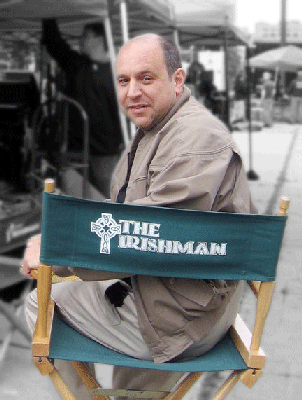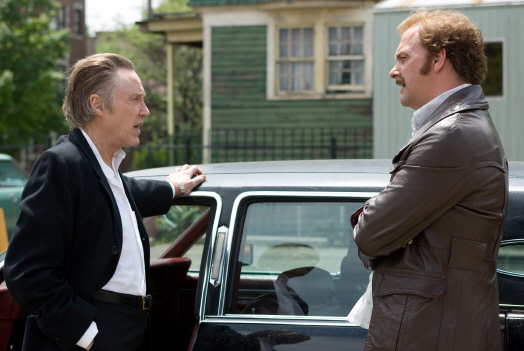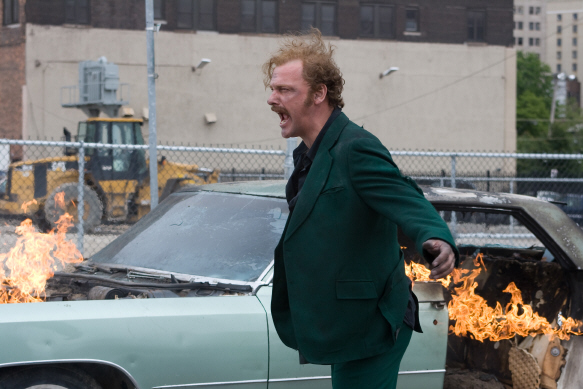During the 1960s and '70s, Danny Greene embarrassed the Cleveland mob by doing something that no other enemy of the syndicate had ever done: he survived.
Despite being shot at and bombed, Greene literally walked away from the scene of the crime. Whereas most people who survive assassination attempts might keep a low profile, Greene, an Irish-American wise guy, granted television interviews where he practically dared his Italian and Jewish rivals to come and get him.
Greene's life as the bane of the Cleveland branch of La Cosa Nostra seems outlandish. It's probably not surprising that the new feature film about him, Kill the Irishman, has been co-written and directed by Jonathan Hensleigh, who's best known for writing escapist fare like Armageddon and Jumanji. Hensley didn't have to embellish the truth much because he includes archival news footage that documents the real Danny Greene's astonishing luck. One of the clips includes a young Cleveland reporter named Brian Ross, who's now the lead investigative correspondent for ABC News.
Rick Porrello's book To Kill the Irishman: The War that Crippled the Mafia, which provides the basis for the movie, thoroughly documents Greene's charmed but turbulent life from his birth to the time he became the corrupt but powerful leader of the Cleveland's International Longshoreman's Association to the moment when his luck finally ran out.
When I asked him by phone if there was any way to quantify how many times Greene missed death, Porrello carefully separated murder attempts from brushes with death. In one case, Greene survived the premature explosion of a dynamite stick that he intended to use on someone else, and in another, attackers fired bullets into Greene's house while he was out. Even after putting the book together, he cautiously estimates seven murder attempts, before saying that one could give or take one attempted homicide.

Porrello's own life might not merit a book or a film, but it is intriguing and gives him some unique qualifications in discussing organized crime. He was a drummer for Sammy Davis, Jr. and later became a cop, eventually becoming the police chief of Lyndhurst, Ohio. His grandfather and his uncles were involved with bootlegging.
He's examined organized crime in two other books: The Rise and Fall of the Cleveland Mafia: Corn Sugar and Blood and Superthief: A Master Burglar, the Mafia, and the Biggest Bank Heist in U.S. History. The latter book is currently in development for a film. He even runs www.americanmafia.com, a site devoted to gangland history. While Porrello has made a career of out keeping people safe from the people he writes about, he happily admits that gangsters can be as fascinating as they are evil.
To Kill the Irishman was originally self-published. How did Tommy Reid (a producer and actress Tara Reid's brother) find out about your book?
There was an article that basically said "Police officer writing book about Danny Greene." And one of his (Ohio State University) OSU buddies found that article and sent it to Tommy. That was pretty much it, and then Tommy got in touch with me. When Tommy first approached me, the book wasn't even on the shelf yet.
You were born in 1962, the year after Danny Greene took over the Cleveland International Longshoremen's Association. How much did you know about Danny Greene growing up?
Almost nothing. But when I was 15 years old, I remember my father was the assistant to the president of the musicians union here in town, basically the head business agent. And he was in his office when (Greene cohort) John Nardi (played by Vincent D'Onofrio in the film) was killed right across the street. He knew John Nardi, and I remember,specifically, him calling one afternoon and telling my mother that John Nardi had just been killed and that basically he was going to be home late.
But I don't remember Danny being killed, and I don't know why because that would have just been later that same year. I don't have a personal recollection of them.
What was it about Greene that made you say, "I've got to document this guy?"
My first book, The Rise and Fall of the Cleveland Mafia, was an extension of my family history and the research I was doing to sort of investigate why I'd had a grandfather who had been killed during Prohibition and why three of them had been killed during prohibition.
It had taken nine years, and after I had published my first book, I vowed I'd never try to write a book again. But once I got the actual copy of that book in my hand -- that book was published commercially -- they sent me my copy, I thought, "I've got to do this again." The Danny Greene story was like a logical sequel.
In The Rise and Fall of the Cleveland Mafia, my grandfather's story was the beginning of the mob. It was the early history. Danny Greene was like the more modern end -- I don't want to say the end of the Cleveland Mob. It really wasn't the complete end. It was sort of the more modern story, and it would make sense to write about.
Not only because of that, but because Danny was such a fascinating character. He went up against the Mob, and they tried to kill him so many different times. He was this proud Celtic warrior, very proud of his Irish heritage, the whole green jacket and green ink (on his business cards) and green car thing. Obviously, there were some producers who would agree with that, too.

Shondor Birns (Christopher Walken) warns his protégé and later rival Danny Greene (Ray Stevenson) about messing with the Mafia. Porrello is now working on a book on Birns. Photo by Kim Simms, Property of Anchor Bay Films, used by permission.
I recently covered another film that has dealt with the Irish Mob. How do Irish wise guys differ from Italian wise guys?
If you talk about La Cosa Nostra, the Italian-American Mob, they were a specific organization with an organization setup. They had a boss, an underboss, a counselor, a soldier, capo regimes. And for the most part, with some variation, across the country, they followed that organizational setup.
The Irish Mob really didn't have that. It was pretty much the bosses and everyone else. They didn't have such a formalized structure. They also didn't have the history that went along with the Mafia being imported from Sicily.
But for the most part, are they organizations that tried to make a lot of money without working too hard and used intimidation and violence and corruption of public officials? Yes. So in that respect, they were similar.
I have a friend who wrote a biography about a long deceased subject who turned out to be a warm and caring person, but what's it like researching someone with blood on his hands?
I dug up a lot of stuff about a lot of these guys, and for the most part they were all killers. But I think what makes it fascinating is the fact that they had other lives, too. Danny Greene had children with three different women. He was a real ladies man. He had fascinating traits that made him a fascinating character.
If you want me to talk about from the perspective of a police chief or as John Q. Citizen, organized crime is a cancer on society. I already knew that, and I'm not writing a dissertation about the effects of organized crime on society. I'm writing a historical entertainment piece. It's just fascinating. I think people just have a natural curiosity about the extremes of society, whether they be the rich, the powerful, the famous, the very good people. But then they have the same curiosity about serial killers and all the bad people, and organized crime falls in that end.
Like Danny, a lot of them had a desire to show people they had a good side, and that's one thing that set Danny aside from some of the others. The guy really was a Robin Hood character. He'd give you the shirt off his back. He gave turkeys away on Thanksgiving and Christmas. He enjoyed being liked by the average people in his neighborhood.
One of the first things I noticed in the film and the book was that all the wise guys in Cleveland at the time seemed long in tooth to be gangsters.
It was really crazy when they inducted John Calandra and Tony Liberatore. These guys were in their 60s, and they were becoming sick. And they're becoming made members of the mafia. It's kind of strange. You usually bring in new members, new blood when they're in their 30s, but not in their 60s.
The whole thing was they had one guy who was in charge for several decades, and he just didn't bring any new blood into the organization. That was John Scalish.
There were a couple of different theories: One, that he didn't want to split profits with anyone else. The other one -- and I tend to go with this one, is that he just didn't trust. He was afraid to bring more people in and make them inducted members because it was a small secret organization. And he wanted to keep it that way. Unfortunately, as time went on, they suffered because of that.
The sheer number of bombings in the book and the film seems really alarming. Was Cleveland worse off than other cities during that time?
As far as bombings, absolutely. There were a lot of bombs going off. I think there was a little misunderstanding during one interview. I think they let it slip by that is was 36 or whatever it was in Cayuhoga County.
That does not in any way translate to 36 people killed. There were 36 cars blown up. These were bombings of all different kinds of sizes. There might have been a business that they were trying to extort that had the windows blown out or maybe a car damaged by a bomb. There were bombings where people were getting seriously injured. It wasn't like there were 36 bombings where people were getting in and people were getting killed. The vast majority did not result in someone being killed, but they were bombings nevertheless, and a bombing commands a lot of attention.
Greene almost seemed to have a death wish because he'd be working out in public parks whereas you or I would keep a low profile if the Mob wanted us dead.
Ultimately that would lead to his death. Danny would spend his later life just living up to his reputation. He had to live up to being Danny Greene. You couldn't intimidate him. He was fearless. He was a Celtic warrior. You couldn't force him from his turf. That was the reputation that he developed. That was the identity that he developed for himself, and he reveled in that. Unfortunately, he had to live up to that, and he was up against an organization that was not going to quit, and it was too far flung, and it was too powerful for him to have continued the conflict and lived.
Once (underboss) Leo Moceri (played by Mike Starr) was killed, they had to kill (Greene). If they had to go to Texas to kill (Greene), they would have done that. Prior to that, they would have been happy to see him go, even after some of the lower guys were killed.

Danny Greene (Ray Stevenson) survives another murder plot. Photo by Kim Simms, Property of Anchor Bay Films, used by permission.
What did you think of the casting of Irish actor Ray Stevenson (Rome) as Danny Greene?
I thought they did a superb job. I loved Ray as Danny Greene. Nancy Greene, Danny's ex-wife thought they did a wonderful job. She thought it was a very good likeness of Danny, and she got to meet him up close and personal at the after party at the Cleveland premiere. That was good enough for me.
Is it tough to juggle being a police chief, an author and a musician?
Well, I'm a fairly new police chief. It's just been two and a half years, and I've been writing for 20 years. I don't play (drums) that much anymore. If I work a job or two a month, that's a lot. I'm kind of always shifting gears.
When (Kill the Irishman) was coming out, I knew I was going to be laying low on the writing and that I wasn't going to be taking any gigs. If I'm busy at work, everything has to wait. The PR people here in town know that everything has to work around my schedule with the police department. I've been doing this so long, and I've got these three books out. So it's not like I became the police chief and started writing. But I make sure I don't let it interfere.
Photo of Rick Porrello from the author's collection, used by permission.
